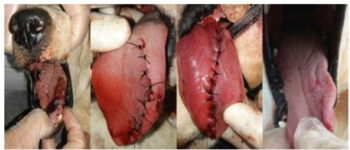Introduction
The tongue is an organ of the digestive system that acts in the seizure, chewing and swallowing of food. Lingual pathologies can significantly compromise the feeding of the animals and nutritional deficit. The most frequent surgical conditions in the tongue are related to neoplasias or traumas.
Objectives
The objective of this study is to describe a case of traumatic laceration in the tongue of a canine with surgical correction.
Methods
A 2-year-old male canine mongrel was treated at VETHO-FUCG with severe lingual bleeding secondary to trauma with longitudinal tongue laceration. He was immediately referred to the surgical center and treated with midazolam (0.3 mg/kg) associated with tramadol (3 mg/kg) IM. For anesthetic induction, propofol (4 mg/kg) IV and maintenance with isoflurane and mandibular nerve block with lidocaine. The prophylactic antibiotic therapy was ampicillin (20 mg/kg) IV. Antisepsis was performed with 0.12% chlorhexidine digluconate. A glossectomy was performed with resection of the apex of the tongue, which showed areas of necrosis. After resection of the edges of the wound the glossorrhaphy was performed throughout the lacerated region, with dorsal and ventral sutures, using 3-0 mono nylon in a single separate pattern. In the postoperative period, clindamycin (10 mg/kg) BID was indicated for 14 days, meloxicam (0.1 mg/kg) SID for 3 days, tramadol (3 mg/kg) TIO for 5 days and antisepsis with chlorhexidine digluconate to 0.12% BID, as well as pasty feed.
| Figure 1. Surgical repair in tongue laceration in a dog | 
|
|
| |
Results
After 10 days the tongue was already healed and the stitches were removed. He fed without difficulty.
Conclusions
We conclude that the surgical and therapeutic procedure adopted was satisfactory.